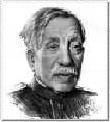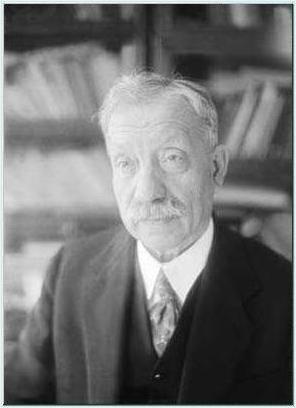Boris Grigoryevich Galerkin was born on February, 20, (March, 4 in new style) 1871 in Polotsk (now in Belarus). His parents owned a house in that town, but homecraft, they were busy with didn't bring enough money. At the age of 12 future academician started working as calligrapher in the Court (probably his smart, but without decoratings, small, but easy readable handwriting was formed at that time). In Polotsk he has finished school, but exams for the additional year, which gave him right to continue education in higher school, he passed in Minsk in 1893 as external student. In the same year he entered St.Petersburg Technological Institute mechanical department.
Lack of money made Boris Grigoryevich combine studying in the institute with working as a draftsman and private tutoring.
Like many other students-technologists he was involved into political activities, joined social-democratic group. In 1899, the year of graduating from the institute, he became a member of the Russian Social-Democratic Party (future Communist Party). Probably this explains the fact of his frequent job changing. First three years after graduation Boris Grigoryevich was an engineer at the Russian Mechanical and Steam-locomotive Union factory in Kharkov, simultaniously teaching workers at special courses. Since the end of 1903 he was an engineer on the construction of Eastern-Chineese Railway, half a year later he became the North mechanical and boiler factory technical department head. He participated in organizing the Union of Engineers in St.Petersburg and in 1905 he was arrested for organizing the strike of engineers. In 1906 Boris Grigoryevich became a member of the Social-Democratic Party St.Petersburg Committee and didn't work anywhere.
Political activity could lead this talanted and energetic person away from science and engineering, but... On July, 23 (August, 5) 1906 the police surrounded the house No.13 in Alexeyevskaya Street, not far from Udelnaya railway station and arrested almost everyone of the Committee members. On March 13 (26), 1907 St.Petersburg Court Chamber passed a sentence, which was strangly light, if to take in account that at the moment of arrest some of the Committee members fired at policemen. One of the 19 Commitee members was imprisoned for two years, 8, including B.G.Galerkin (or "Zakhar", according to his underground nickname) - for 1,5 years, others were discharged.
In prison, known under the name "Kresty", Boris Grigoryevich has lost interest to revolutionary activities and devoted himself to science and engineering. Prison conditions of that time were giving such opportunity. And what is more, in his work-book it is written that Boris Grigoryevich worked as an engineer at designing and constructing of the boiler power plant (later -the 1st state power plant) since 1907. This fact wasn't explained, and Boris Grigoryevich didn't like to remind his revolutionary youth. Later, in Soviet questionnaires he didn't give clear answers on the persistent questions about membership in different parties. Of course, he was familiar with the fate of old Party members, but the main reason for it was that he had been elected to the Committee from the Menshevists (a Party group with non-radical views, which members later were accused in contr-revolutionary activities and repressed). B.G.Galerkin's life could become the price for the publicty of this fact.
Boris Grigoryevich was discharged in the end of 1908. In March he became a teacher in St.Petersburg Polytechnical Institute. The same year his first scientific work was published in the institute "Transactions". It was "A theory of longitudal curving and an experience of longitudal curving theory application to many-storied frames, frames with rigid junctions and frame systems". The work with such long name was long itself (130 pages). It was written in the "Kresty" prison. In summer 1909 Boris Grigoryevich had a trip abroad to see constructions and buildings, which interested him. Next four years, i.e. before the World War I, he, as well as many other institute officers, was visiting Europe to satisfy his scientific interests. He has been in Germany, Austria, Switzerland, Belgium and Sweeden.
B.G.Galerkin teached students of the mechanical department structural mechanics, i.e. conducted exersises and designing. The lecturer was professor
V.L.Kirpichov - a famous scientist in the field of mechanics and per se the head of the Petersburg mechanical scientific school. However, its members mostly also worked in Polytechnical Institute, for example: I.G.Bubnov, A.N.Krylov, I.V.Meshcherskiy, S.P.Timoshenko.
Since autumn I9II Boris Grigoryevich also worked in Womens' Polytechnical Institute. In 1913 he worked over the designing of the metallic frame for a boiler power plant in St.Petersburg - the first building with metallic frame under big loads in Russia. Later it was considered to be one of the unique European engineering objects. B.G.Galerkin regulary published his works in the Institute "Transactions", and since I9I5 - also in "Engineering News". Before 1915 pivot systems were in the center of his scientific interest, later he started researching plates.
In 1915 B.G.Galerkin published an article, in which he put forward an idea of differential equations boundary problems approximate solution method. He has applied his method to a big number of pivots and plates analysis problems. Some time before I.G.Bubnov developed similar approach for the variational problems solution, which he interpreted as a variant of Ritz method algorythm. The distinguishing features of Galerkin's method were following: he didn't assotiate method, developed by him, with variational problems direct solution, but considered it to be common for solving the differential equations and interpreted it, using the probable displacements principle. These ideas occured to be very productive, not only in structural mechanics, but in whole mathematical physics.
Galerkin method (or Bubnov-Galerkin method) with Galerkin's (or "weak") differential equations problem statement form are known all over the world. Nowadays they underlie numerous problems of mathenatical phisics solution algorythms in the fields of mechanics, thermodynamics, electromagnetism, hydrodynamics and many others. A lot of software products are based on Galerkin's method algorythm. In Internet one can find thousands links on Galerkin method.
In January 1919 Boris Grigoryevich became a professor in the 2nd (former Womens') Polytechnical Institute, remaining a teacher of structural mechanics in the 1st Polytechnical Institute (at that time Polytechnical Institute was named so) mechanical department. In March 1920 a professor chair in structural mechanics was established at that department, and Boris Grigoryevich took it in a competition. In summer 1921 S.P.Belzetskiy, a famous scientist in the field of structural mechanics and theory of elasticity, who was holding the similar chair at civil-engineering faculty, emigrated to Poland. Boris Grigoryevich took part in a competition for his chair and in the beginning of 1922 he left mechanical faculty for civil-engineering faculty, which was nearer to him in his scientific and engineering activities.
However his talent at that time wasn't wanted by anyone and he could concentrate in scientific problems. Before, in 1917-1919 Boris Grigoryevich published a series of works on rectanglar and triangular plates curving in scientific periodicals, mentioned above, and in the "Russian Academy of Sciences Transactions". Later he had a break in publications, and only in 1922 they appeared again, but in foreign magazins (in Soviet Russia there wasn't enough paper for scientific literature).
In December 1923 Boris Grigoryevich was elected a dean of the Polytechnical Institute civil-engineering faculty. It has happened in a very important period of the institute history, when a group of deans resigned from their posts, protesting from unceremonious intervention of so called "students' representitives", controlled by tred-union and communist party committees, into the educational process. Boris Grigoryevich occured to be a talented leader of the faculty. He managed to neutralize too active "assistants", who were appointed against his will, and he didn't hurry to fulfill the orders of incompetent leaders, who were conducting infinite experiments in the higher school at that time. In 1924 - 1929 Boris Grigoryevich was also a professor in the Railway Engineers Institute and in the University. In 1924 he made his last trip abroad - he participated in the Congress on applied mechanics in Netherlands.
In spring 1926 Boris Grigoryevich learned that Narkompros (Ministry of education) had adopted a desision to close the road-making section at his faculty. This desision was prepeared and adopted secretly from the dean by the institute communist party committee in the connection with the company on elimination of parallel specialities. Meanwhile, there were no other faculties in the country, training specialists in the construction of electrificated railways, urban railways and subways (our faculty worked in this sphere since 1907). Boris Grigoryevich obtained the cancellation of this rash desision in Moscow. During the period of Boris Grigoryevich's working on the dean's post, the first laboratory on the faculty (hydrotechnical, now -hydraulic, built to the watertower) was created. He also managed to receive the governmental approval of the idea to built some other big laboratories for the faculty (Hydrotechnical Research Institute was later established on their base).
In January 1928 Boris Grigoryevich was elected the USSR Academy of sciences corresponding member. His candidature was nominated by academicians A.F.Yoffe, A.N.Krylov, P.P.Lazarev. In October 1929 he left the dean's post. After it the civil-engineering faculty was divided into two parts: its hydrotechnical and irrigation sections became the water industry faculty, and the rest part of the civil-engineering faculty soon was left out of the Polytechnical Institute and became the Civil and Industrial Engineering Institute, which, however, didn't exist for a long time. Water industry faculty soon also became an institute – Hydrotechnical. Boris Grigoryevich was a professor in both institutes.
Boris Grigoryevich in 1920-s already was a world-famous scientist. Also he was very authoritative among engineers-designers. He was often recruited as a consultant to the designing and construction of serious undustrial objects in the North-West of the country (heat power plants, Volkhov hydro power plant, Kondopoga pull-and-paper mill and others). He was a member of technical Councils in designing institutes Gipromez and Giprotsvetmet, member of Academic Councils in research institutes: Irrigation Institute (later - Hydrotechnical Research Institute), Institute of Structures. After the end of the Dnyepr Hydro power plant construction Boris Grigoryevich was a member of the governmental comission, accepting it.
In 1934 Boris Grigoryevich got two doctoral degrees in technics and mathematics and Russian Federation Science and Technics honoured worker title. In the beginning of 1936 he was elected a member of the USSR Academy of sciences. He also became a member of the Highest Certifying Commission in the state Committe on higer technical education, a chairman of the technical mechanics group in the USSR Academy of sciences technical section, the headmaster of the USSR Academy of sciences Institute of Mechanics, the chairman of the Civil engineers scientific society and its Leningrad section. In April 1936 according to the governmental order Boris Grigoryevich was appointed a chairman of the Governmental Commission for the examination of the Moscow Palace of Soviets (which was to become the most pompous building on the planet) steel frame walls and overlappings initial project.
Though having so many titles, Boris Grigoryevich remained a professor of the structural mechanics and theory of elasticity department at hydrotechnical faculty (Hydrotechnical Institute was returned to the Polytechnical (at that time - Industrial) Institute as a faculty in 1934). Mostly he read the course of the theory of elasticity, which was very difficult for the students of that time, who had a very weak training in mathematics. Students were visiting his lectures to look at the "real academician", but he dissapointed them. He was short, puny, had a weak voice. His image didn't correspond to the status of serious scientist with big authorities, received from the government. Once academician even was pulled out of a tram by other well-grown passangers, and after this accident the institute administration applied to the authorities for rendering Boris Grigoryevich a car.
 In 1939 when the military-construction school was formed on the base of Civil and Industrial Engineering Institute, Boris Grigoryevich as the head of its structural mechanics department and academician became general-leutenant. Boris Grigoryevich had never been in army before, but had to wear general's uniform. He was shy and when somone raported to him he usually got frightened and waved hands.
In 1939 when the military-construction school was formed on the base of Civil and Industrial Engineering Institute, Boris Grigoryevich as the head of its structural mechanics department and academician became general-leutenant. Boris Grigoryevich had never been in army before, but had to wear general's uniform. He was shy and when somone raported to him he usually got frightened and waved hands.
In summer 1941 after the beginning of the war the Commission on the defensive installations construction was created by the city powers. Some academicians and prominent scientists became its members (almost everyone was from Polytechnical Institute), but only Boris Grigoryevich was related with construction engineering, practically it was he, who supervised the work of the Commission. Simultaniously Boris Grigoryevich was the city engineering defence department experts group head.
Later he was evacuated to Moscow, where he joined the military engineering commission of the USSR Academy of sciences. Hard non-stop work was undermining the scientist's health. Not long after the Great Victory, on July, 12, 1945 Boris Grigoryevich Galerkin died in Moscow.


 |
Saint-Petersburg State Polytechnical University |
| STRUCTURAL MECHANICS AND THEORY OF ELASTICITY DEPARTMENT |
 |



 In 1939 when the military-construction school was formed on the base of Civil and Industrial Engineering Institute, Boris Grigoryevich as the head of its structural mechanics department and academician became general-leutenant. Boris Grigoryevich had never been in army before, but had to wear general's uniform. He was shy and when somone raported to him he usually got frightened and waved hands.
In 1939 when the military-construction school was formed on the base of Civil and Industrial Engineering Institute, Boris Grigoryevich as the head of its structural mechanics department and academician became general-leutenant. Boris Grigoryevich had never been in army before, but had to wear general's uniform. He was shy and when somone raported to him he usually got frightened and waved hands.

![]()